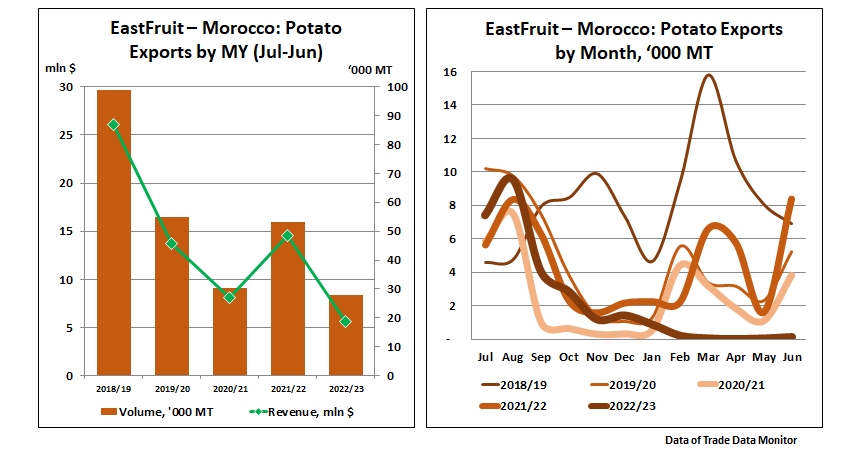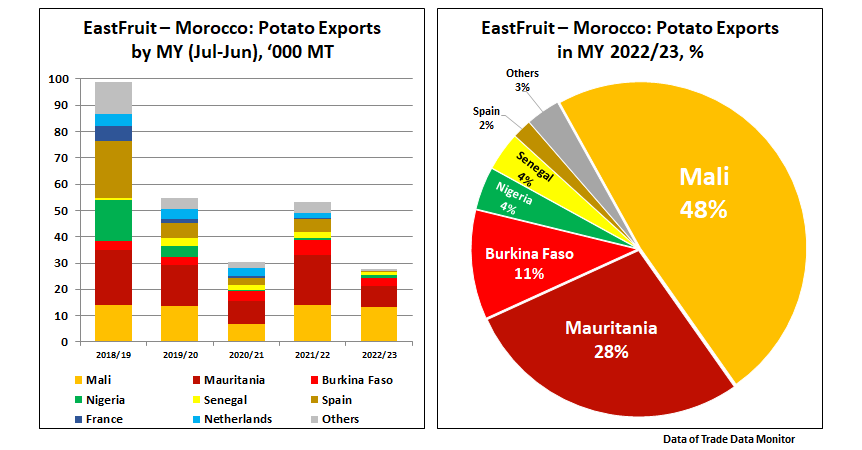Morocco, as one of the leading global suppliers of fruits and vegetables, is increasing its exports of fruit and vegetable products, but this is not relevant for all the items. In today’s article, EastFruit draws attention to the fact that the Moroccan fresh potato exports have shown a negative trend for several years, and the shipments in the MY 2022/23 fell to a minimum.

Four years ago, Moroccan potato exporters managed to deliver about 100,000 tons of their produce (valued at $26 million) to foreign countries. However, since then, external sales have been decreasing almost every year by 44-48%, while the export revenue has dropped almost 5 times in a few years, and Morocco moved from 21st place in 2019 to 25th in 2022 in the list of world exporters. The current season was even worse – for the period from July to June, only 27,900 tons of potatoes were delivered to foreign markets, respectively, sales brought the minimum revenue for five years – $5.7 million.
Read also: Moroccan frozen raspberry exports to Spain: record-breaking volume, but decreased revenue in 2022/23
At the same time, the geography of potato supplies from Morocco has expanded significantly. For example, in the MY 2016/17, Moroccan potatoes were delivered only to 24 foreign markets, and today they reach consumers in 44 countries.
Despite the fact that European countries occupy leading positions in the list of world importers of potatoes, the main destinations for such supplies from Morocco are primarily African countries.
It should be noted that the Moroccan potato exports to the EU reached their maximum in the MY 2018/19, when Europe faced a severe drought. Moroccan suppliers increased sales to European countries (for example, 22,000 tons of potatoes were delivered from Morocco just to Spain) amidst the emerging deficit. Then, a year later, supplies to European markets decreased significantly and are practically absent today.

As for African countries, here the main consumers of Moroccan tubers are located in the Sub-Saharan part of the continent, namely in the western part of the Sahel region. Morocco exports potatoes to Mauritania, Burkina Faso, Nigeria, Senegal, and almost half of all supplies go to Mali. The climate in this area is problematic – often storms and floods are replaced by droughts, so countries in this region need to import fruit and vegetable products from abroad.
In turn, in February 2023, the Moroccan government banned the export of potatoes, onions and tomatoes to African countries as part of the fight against rising prices for these products. This decision certainly affected foreign trade, so the result of the 2022/23 season are quite obvious.
This analysis included the data on exports of ware potatoes, without taking into account seed ones. Moroccan growers practically do not export potatoes for planting, but on the contrary, it is imports of seed potatoes that have been growing rapidly. Seed potatoes in Morocco are the second (after dates) product of the fruit and vegetable group and for the MY 2022/23 a record volume of this product for the last 5 years was imported into the country.
In such a way, taking into account the growth of imports of seed potatoes, one can expect a probable increase in potato production in the next season and, as a consequence, a possible increase in exports. Whether the forecast comes come true will be seen at the end of the season.
The use of the site materials is free if there is a direct and open for search engines hyperlink to a specific publication of the East-Fruit.com website.




